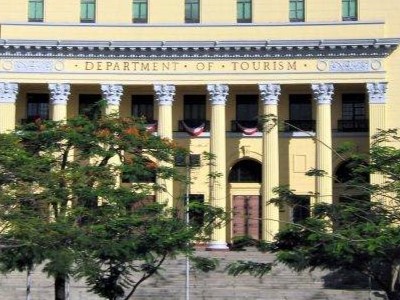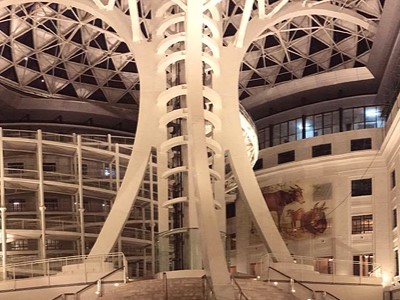History
The building was constructed as the Agriculture and Commerce Building in 1940 and designed in neoclassical style by Filipino Architect Antonio Toledo in the late 1930s, having the same dimension and floor plan as its twin building located at the northern side of the circle, the Finance Building. Similar with the Department of Finance Building, a grand stairway as broad as the concave northwest façade of the Department of Agriculture Building serves as the main access rising up to the columned portico on the second floor level. The portico features six fluted columns with Corinthian capitals. Four arched openings are distributed alternately with rectangular windows in the seven bays of the northeast entrance wall.
The Department of Agriculture and Commerce building was among the government buildings reconstructed in 1949, under the government’s post-war rehabilitation work program. In February 1945 the American forces bombarded the building with heavy artillery fire (from February 25 until February 28), concentrated on the ground floor until the lower sections have been pulverized and the upper sections settled on the ground. Symmetrical with the Department of Finance Building, the five-story Department of Agriculture and Commerce Building has an odd trapezium plan with a chamfer at its southeast obtuse vertex and a concave side on its northwest fronting the rotonda. A ground level approach on a driveway protected by a three-arched porte cochere serves as the entrance at the chamfered southeast corner of the building. Halls and rooms are orthogonally arranged around the central courtyard of the same trapezium shape. A modest pediment accentuates the chamfered corner entrance.
Keeping its historical value, the building reconstruction using the adaptive reuse architecture or the restoration of an old building to convert it into a space for something other than its original purpose commenced in 2013. What used to be a building occupied by the Department of Tourism is now home to displays of diverse botanical, zoological, and geological collections of the country. As the present National Museum of Natural History, the recent new additions on the east and west of the original building footprint, and on top of the original building height, serve as the museum building’s facilities, offices and public spaces. The metal-framed glass dome known as the “Tree of Life” now covers the central courtyard. The open spaces southeast of the building serve as a visual corridor where one can enjoy the perspectives of the surrounding urban spaces and the other neo-classical buildings.
Prior to its public opening, on June 28, 2016, the National Museum of Natural History was initially launched through the ceremonial turnover of the Tree of Life, which was unveiled by President Benigno Aquino III through his cabinet secretaries as representatives. On May 18, 2018, highlighting the International Museum Day celebration, the long time coming National Museum Complex was finally realized through the public opening of the National Museum of Natural History. It has the concept of presenting its collections from the mountain to the sea, which are exhibited through interactive displays, video guides, diagrams, and illustrations integrated to zoological, botanical, and geological specimens on display at the 12 galleries and its halls. Today, it has been one of the most visited educational tourist destinations in Metro Manila.



